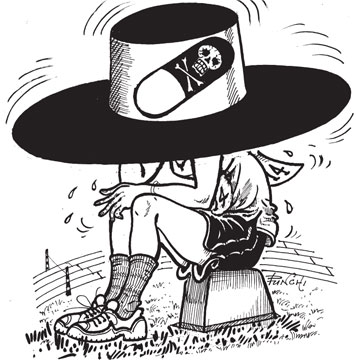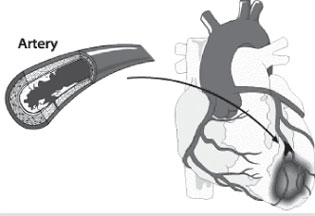|

 Practice regularly, say ‘no’ to drugs Practice regularly, say ‘no’ to drugs
By Nilma DOLE
‘Do sports, not drugs’ was a United Nations campaign that showed that
there was an increase in drug use among the youth when it came to
performing in sports. Where competition is strife on an international
stage, pressure is always mounting on our nation’s sportstars to perform
well, but everything is lost when the truth of drug use surfaces.
If the root of the problem isn’t tackled, sports personalities will
take drugs for granted and when they test positive for drugs, they don’t
realise the disgrace they bring on to them and their nation.
Taking former world champion, Marion Jones, it was with the pressure
of having to perform well that drove her to take drugs.
We admired her when she beat our nation’s sprint queen, Susanthika
Jayasinghe to take home the gold.
But we didn’t know the other side of her story which was a stunning
athletic career laced with performance-enhancing drugs.
Even though she won five medals at the 2000 Summer Olympics in
Sydney, Australia she was stripped of her awards after her October 2007
admission, after she admitted to taking drugs, lying to a grand jury
investigating performance-enhancer creations by Victor Conte and the Bay
Area Laboratory Co-operative (BALCO).
Today, we admire Susanthika for practising hard and now a silver
medal winner at the 100 metres for not needing anything but strength and
determination to win the race.
Speaking to the Sunday Observer was Consultant Neurologist and
co-founder of Sri Lanka’s NADO (National Anti-Doping Organisation), Dr.
Githanjan Mendis.
Strength
“In the sporting world, banned substances have been introduced by
WADA (World Anti-Doping Agency) to combat taking drugs by sports men and
women to improve their power, speed, strength and endurance,” said the
doctor.
|
Prohibited Methods and Substances:
S1 - Anabolic Agents
S2 - Hormones, growth factors and related substances
S3 - Beta 2 Agonists
S4 - Hormone Antagonists and Modulators
S5 - Diuretics and other Masking Agents
S6 - Stimulants
S7 - Narcotics
S8 - Cannabinoids
S9 - Glucocoticosteroids
M1 - Enhancement of Oxygen Transfer, Blood Doping and Erythroprotein
M2 - Pharmacological, Chemical and Physical, Manipulation
M3 - Gene Doping
P1 - Alcohol
P2 - Beta-blockers
References - www.patient.co.uk and NADO pocket directory 2010
|
The World Anti-Doping Agency was established in 1999 with the head
office based in Montreal, Canada.
The World Anti-Doping Agency (WADA) was founded with the belief that
‘athletes have a fundamental right to participate in doping-free sport
and that doping endangers athlete’s health and the integrity of sport.’
The doctor said that it serves as the independent international body
responsible for coordinating and monitoring the global fight against
doping in sport.
He said, “WADA has an aim to eradicate ‘drugs in sports’ because this
has become a menace in the sporting world.”
He said that sportsmen and women tend to take these banned substances
when they have not done enough training and to enhance their
performance.
“Anybody can perform well in international sports provided they do
the training, practice and have mental stability when it comes to
performing well,” said the doctor. He said that Sri Lankan sportstars
don’t need to take drugs if they want to bring home the gold medal. “If
only they perform, train well and put their minds to winning, they can
shine without drugs,” he said. “Sri Lanka is also the same because they
don’t do enough pratice and they take these drugs,” he said. Dr. Mendis
explained that by taking these substances, it will perish their body and
organs and also it is unfair to the other athletes by taking these.
Laboratory
Sri Lanka’s National Anti-Doping Organisation (NADO) is affiliated to
WADA where urine samples of athletes are sent to India for sample
testing. He said,“Sri Lanka doesn’t have its own anti-doping laboratory
because it is expensive to maintain one with state-of-the-art
facilities.
There are five countries in Asia that have WADA lab facilities and
they are Japan, South Korea, China, Thailand and India.” The biggest
problem is denying taking drugs because while athletes might fail drug
tests, they always deny ever knowingly having taken a banned substance.
The doctor said, “Sportstars are not average people.
For example, sprinters have low fat content and more muscule. Since
fat is important in the metabolism of steroid hormones, there is a small
percentage of sprinters who can perform exceptionally well without
drugs,” he said.
A majority of major athletes use dietary supplements but the contents
of what they use have been questionable.
Although it is undoubtedly the case that some athletes are guilty of
deliberate cheating, some positive tests are likely to be the result of
inadvertent ingestion of prohibited substances present in otherwise
innocuous dietary supplements. Moreover, there is always a war waging
between those seeking new techniques to detect illicit use of
performance enhancing substances and those who wish to circumvent the
rules.
Limits
Some argue that the human body should be tested to the maximum limits
but does it have to be done at a cost? What athletes don’t realise is
that it will put their lives in jeopardy and bodies at risk if they are
constantly using drugs and performance-enhancers as this could be
deadly.
 |
|
Dr. Githanjan Mendis receives a merit
award at the World Anti- Doping conference in Saudi Arabia |
The problem of stimulants in sport reached public attention in 1960
when the Danish cyclist Knut Jenson died in the Rome Olympics and it
transpired that he had been taking amphetamines.
In addition to this, testing for drugs through urine should be
vigorous and can be unannounced and the penalties for being discovered
are severe.
But for every action, there is an equal but opposite reaction and
there will always be those who attempt to use illicit ways of enhancing
performance to get the necessary slight edge that is required to win.
In the future, gene doping is looking to be the next way to
performance-enhancing.
The World Anti-Doping Agency describes gene doping as 'the
non-therapeutic use of cells, genes, genetic elements, or of the
modulation of gene expression, having the capacity to improve athletic
performance'.
Insulin
The potential for gene doping would be to inject ‘normal’ genes into
the body to increase the functioning of a ‘normal’ cell. For example,
genes producing insulin growth factor 1 to help muscles grow and repair.
The forthcoming London 2012 Olympics will be an important event in
ensuring free and fair sporting achievements.
According to the authorities, various proposals have been made with
the possibility of trialling a doping ‘passport’ to be carried by all
athletes.
This would be done in a bid to record the results of doping tests and
natural concentrations of hormones such as erythroprotein during their
careers, the idea being that this would make it easier to detect any
substance abuse.After our boxing champion lost a valuable gold medal at
a prestigious world games due to drugs, let’s hope our Sri Lankan
hopefuls will bring home a few Olympic medals without taking drugs!
Maternal liver grafts more tolerable for children with rare disease
Children with a rare, life-threatening disease that is the most
common cause of neonatal liver failure - biliary atresia - better
tolerate liver transplants from their mothers than from their fathers,
according to a UCSF-led study.
In the study, researchers reviewed all paediatric liver transplants
nationwide from 1996 to 2010, and compared the outcomes for patients who
received liver grafts from their mothers with those for patients who
received livers from their fathers.
 Researchers believe the improved outcomes for children receiving a
maternal liver graft may be due to higher levels of maternal cells in
the patients’ livers. The presence of these cells may establish
tolerance to maternal antigens - substances that induce an immune
response - and therefore greater acceptance of maternal organs in these
biliary atresia patients. Researchers believe the improved outcomes for children receiving a
maternal liver graft may be due to higher levels of maternal cells in
the patients’ livers. The presence of these cells may establish
tolerance to maternal antigens - substances that induce an immune
response - and therefore greater acceptance of maternal organs in these
biliary atresia patients.
“This result is exciting because it supports the concept that
trafficking of cells between the mother and the foetus has functional
significance long after the pregnancy is over,” said senior author Tippi
MacKenzie, MD, assistant professor of pediatric surgery at UCSF and a
fetal surgeon at UCSF Benioff Children’s Hospital.
“This is a topic we are actively studying both in animal models and
in patients who have foetal surgery. Practically speaking, this study
may allow us to counsel families in which both the mother and father are
willing and able to be a donor.”
The researchers found that patients with biliary atresia who received
a transplanted maternal portion of liver had a failure rate of 3.7
percent, compared to the failure rate of 10.5 percent observed in
recipients of paternal livers.
In children who had liver transplantation for other diseases, there
were no differences in the transplant outcome between maternal or
paternal grafts.
The results will be published in this month's issue of the American
Journal of Transplantation and can be found online.*
Biliary atresia, which affects one in 10,000 newborn infants, occurs
when the common bile duct between the liver and the small intestine is
blocked or absent.
While early surgical intervention to treat biliary atresia is
critical to prevent irreversible liver damage, once the liver fails, a
liver transplant is required.
“We were testing the idea that if cells from the mother travel into
the fetus during pregnancy and are involved in maternal-fetal tolerance,
this phenomenon may have a long-lasting effect for transplantation
tolerance when the mother donates an organ to the child,” MacKenzie
said.
- Sciencedaily.com
How muscle growth is triggered by exercise
We take it for granted, but the fact that our muscles grow when we
work them makes them rather unique.
Researchers have identified a key ingredient needed for that bulking
up to take place. A factor produced in working muscle fibers apparently
tells surrounding muscle stem cell “higher ups” that it’s time to
multiply and join in, according to a study in the January Cell
Metabolism.
 In other words, that so-called serum response factor (Srf) translates
the mechanical signal of work into a chemical one. In other words, that so-called serum response factor (Srf) translates
the mechanical signal of work into a chemical one.
“This signal from the muscle fibre controls stem cell behaviour and
participation in muscle growth,” said Athanassia Sotiropoulos of Inserm
in France. “It is unexpected and quite interesting.” It might also lead
to new ways to combat muscle atrophy.
Sotiropoulos’ team became interested in Srf’s role in muscle in part
because their earlier studies in mice and humans showed that Srf
concentrations decline with age. That led them to think Srf might be a
culprit in the muscle atrophy so common in aging.
The new findings support that view, but Srf doesn’t work in the way
the researchers had anticipated. Srf was known to control many other
genes within muscle fibres. That Srf also influences the activities of
the satellite stem cells came as a surprise.
Mice with muscle fibers lacking Srf are no longer able to grow when
they are experimentally overloaded, the new research shows. That’s
because satellite cells don’t get the message to proliferate and fuse
with those pre-existing myofibers.
Srf works through a network of genes, including one known as Cox2.
That raises the intriguing possibility that commonly used Cox2
inhibitors - think ibuprofen - might work against muscle growth or
recovery, Sotiropoulos notes. Treatments designed to tweak this network
of factors might be used to wake muscle stem cells up and enhance muscle
growth in circumstances such as aging or following long periods of bed
rest, she said. Most likely, such therapies would be more successfully
directed not at Srf itself, which has varied roles, but at its targets.
“It may be difficult to find a beneficial amount of Srf,” she said.
“Its targets, interleukins and prostaglandins, may be easier to
manipulate.”
- Macular.lastmed.com
Link between heart failure and diabetes
Either heart failure or diabetes alone is bad enough, but often times
the two conditions seem to go together. Now, researchers reporting in
the January Cell Metabolism appear to have found the culprit that leads
from heart failure to diabetes and perhaps a novel way to break that
metabolic vicious cycle.
“Our findings clarify the reasons why the incidence of heart failure
is high among diabetic patients, why the prevalence of insulin
resistance is increased in heart failure patients, and why treatment of
insulin resistance improves the prognosis of heart failure patients,”
said Tohru Minamino of Chiba University Graduate School of Medicine.
 It’s a domino effect, the new evidence shows: the stress of heart
failure activates the sympathetic nervous system. That stress response
activates p53, which Minamino calls a cellular aging signal. It’s a domino effect, the new evidence shows: the stress of heart
failure activates the sympathetic nervous system. That stress response
activates p53, which Minamino calls a cellular aging signal.
That p53 signal ultimately leads to inflammation in fat tissue,
systemic insulin resistance, and worsening heart function.
Of course, the protein p53 is probably best known as a tumor
suppressor.
“It has been reported that p53-dependent cellular aging is a
protective mechanism for cancer development,” Minamino said. But, he
adds, constant activation of the anticancer signal can promote
inflammation, cancer, and other diseases of aging.
Minamino had earlier shown that age-associated or stress-induced
accumulation of p53 in the heart promotes heart failure.
Aging and extra calories induce that same aging signal in fat tissue.
Now it seems that activation of cardiac p53 also leads to activation
of p53 in fat tissue.
Those p53-dependent cellular aging signals in both tissues interact
with each other, thereby accelerating the development of age-associated
diseases, he said.
This suggests that an ideal treatment would block the inflammation
that goes with p53’s activation without compromising its tumor-fighting
abilities.
And for Minamino, that’s the Holy Grail: an antiaging therapy without
the cancer risk.
- MNT
|

